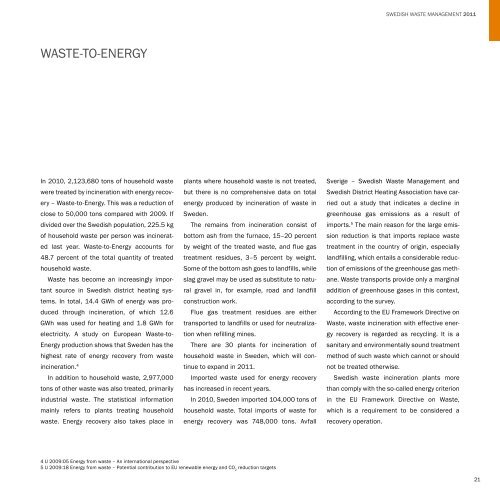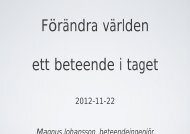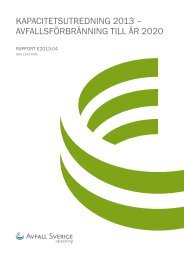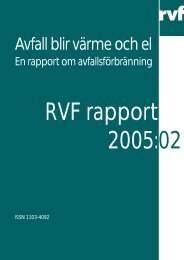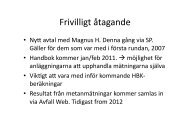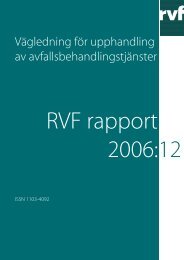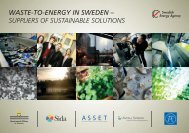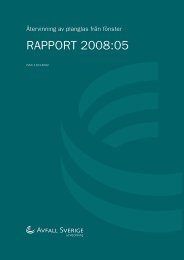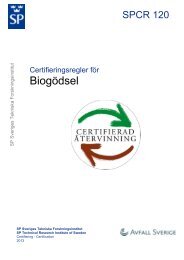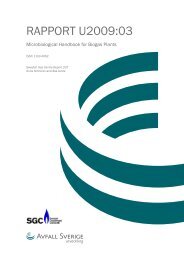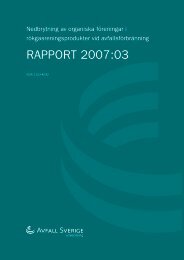SwediSh waSte management |2011 - Avfall Sverige
SwediSh waSte management |2011 - Avfall Sverige
SwediSh waSte management |2011 - Avfall Sverige
Create successful ePaper yourself
Turn your PDF publications into a flip-book with our unique Google optimized e-Paper software.
Swedish waste <strong>management</strong> 2011Waste-to-EnergyIn 2010, 2,123,680 tons of household wastewere treated by incineration with energy recovery– Waste-to-Energy. This was a reduction ofclose to 50,000 tons compared with 2009. Ifdivided over the Swedish population, 225.5 kgof household waste per person was incineratedlast year. Waste-to-Energy accounts for48.7 percent of the total quantity of treatedhousehold waste.Waste has become an increasingly importantsource in Swedish district heating systems.In total, 14.4 GWh of energy was producedthrough incineration, of which 12.6GWh was used for heating and 1.8 GWh forelectricity. A study on European Waste-to-Energy production shows that Sweden has thehighest rate of energy recovery from wasteincineration. 4In addition to household waste, 2,977,000tons of other waste was also treated, primarilyindustrial waste. The statistical informationmainly refers to plants treating householdwaste. Energy recovery also takes place inplants where household waste is not treated,but there is no comprehensive data on totalenergy produced by incineration of waste inSweden.The remains from incineration consist ofbottom ash from the furnace, 15–20 percentby weight of the treated waste, and flue gastreatment residues, 3–5 percent by weight.Some of the bottom ash goes to landfills, whileslag gravel may be used as substitute to naturalgravel in, for example, road and landfillconstruction work.Flue gas treatment residues are eithertransported to landfills or used for neutralizationwhen refilling mines.There are 30 plants for incineration ofhousehold waste in Sweden, which will continueto expand in 2011.Imported waste used for energy recoveryhas increased in recent years.In 2010, Sweden imported 104,000 tons ofhousehold waste. Total imports of waste forenergy recovery was 748,000 tons. <strong>Avfall</strong><strong>Sverige</strong> – Swedish Waste Management andSwedish District Heating Association have carriedout a study that indicates a decline ingreenhouse gas emissions as a result ofimports. 5 The main reason for the large emissionreduction is that imports replace wastetreatment in the country of origin, especiallylandfilling, which entails a considerable reductionof emissions of the greenhouse gas methane.Waste transports provide only a marginaladdition of greenhouse gases in this context,according to the survey.According to the EU Framework Directive onWaste, waste incineration with effective energyrecovery is regarded as recycling. It is asanitary and environmentally sound treatmentmethod of such waste which cannot or shouldnot be treated otherwise.Swedish waste incineration plants morethan comply with the so-called energy criterionin the EU Framework Directive on Waste,which is a requirement to be considered arecovery operation.4 U 2009:05 Energy from waste – An international perspective5 U 2009:18 Energy from waste – Potential contribution to EU renewable energy and CO 2reduction targets21


